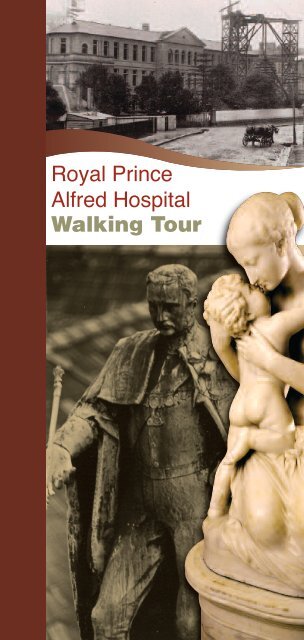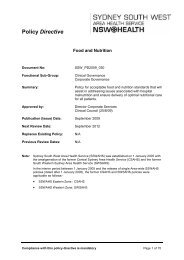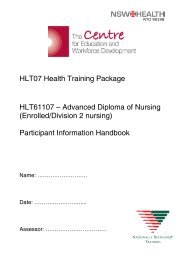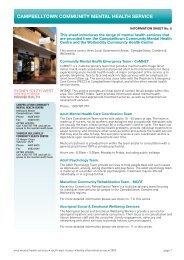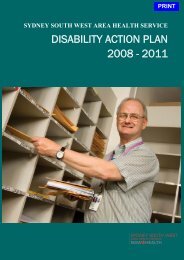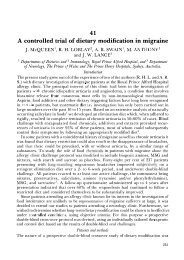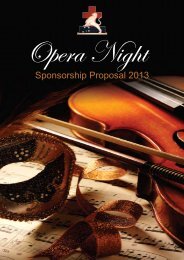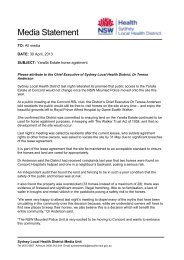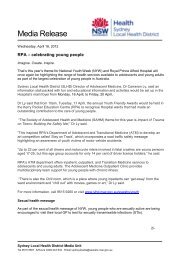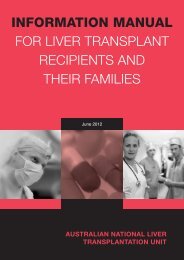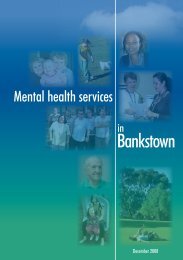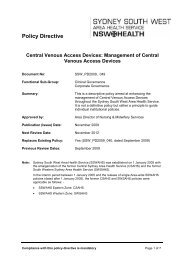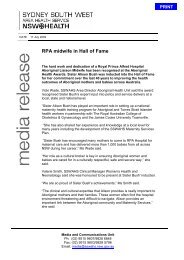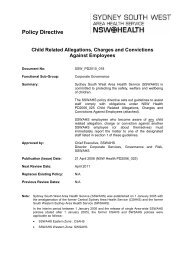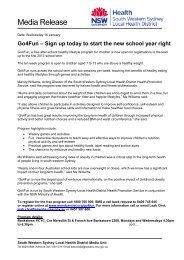RPA Walking Tour - Sydney South West Area Health Service
RPA Walking Tour - Sydney South West Area Health Service
RPA Walking Tour - Sydney South West Area Health Service
You also want an ePaper? Increase the reach of your titles
YUMPU automatically turns print PDFs into web optimized ePapers that Google loves.
Royal PrinceAlfred Hospital<strong>Walking</strong> <strong>Tour</strong>
Welcome to theRoyal Prince Alfred Hospitalself-guided <strong>Walking</strong> <strong>Tour</strong>This tour circles around the main buildings of theHospital travelling along Missenden Road, downGloucester House Drive, around Lambie Dew Driveand up Johns Hopkins Drive. It is about 1.5k longand will take approximately 45 minutes – more ifvisitors want to stop at the Museum and have a lookaround.Please stay on the footpaths as much as possibleor on the side of the road, especially along LambieDew Drive at the back of the Hospital where it isbest to stay on the University-side of the drive. Also,be mindful of uneven ground and downwardslopes. There are also some steps at differentplaces on the walk.There are several benches and places to rest alongthe walk. Refreshments can be purchased on bothLevels 4 and 5 of the Royal Prince Alfred Hospitalwhere there are two cafes – the former overlookingthe beautiful Jacaranda tree and garden behindGloucester House. Ask at the Enquiries Desk fordirections. There are also cafes and shops alongMissenden Road to the North of the Hospital site.Self-Guided <strong>Walking</strong> <strong>Tour</strong>If there are any questions, Dr Kathryn Hillier,Hospital Historian, can help!P: 9515 9201E: kathryn.hillier@email.cs.nsw.gov.auW: www.sswahs.nsw.gov.au/rpa/museumGuided tours can be arranged. Contact Dr Hillier formore information.This tour can be linked to the “Medical HeritageTrail” arranged by the Faculty of Medicine,University of <strong>Sydney</strong>. For more information, contactDr Lise Mellor on 9036 3366W: www.medfac.usyd.edu.au/medicine/museum/2
Stop 1.......This is one of only two buildings extant from theoriginal Hospital. Although the Hospital opened in1882, the Administration Block was not ready foruse until 1884.Inside you will see several beautiful stained-glasswindows and busts of prominent <strong>RPA</strong> men fromthe late 19th and early 20th century. There is alsoa bust of Florence Nightingale which was relocatedto this spot from the Queen Mary Nurses’ Home in2005. Feel free to walk in and have a look around.In addition to the administrative offices andquarters for the medical and nursing staff, thebuilding originally housed the medical library, theoutpatients department, a dispensary, a waitingroom for patients requesting admission or for theirvisitors and two beds for accident cases.The Administration BlockOriginally a large wooden staircase sat in the centreof the foyer and was staffed by the Hall Porter,Mr James Crombie, who held the post for 22 years.His job was to monitor all comings and goings andto keep track of which physicians and surgeonswere on duty.4
Stop 1.......Outside the building there was a high paling fencewith wooden gates leading to a carriageway on thesouthern end with gaslight lamps at the entranceand the porter’s lodge on the right. The woodenfence was replaced by a stone wall in the 1890sand then by a small dwarf wall with stone posts.The front gardens have always been a source ofpride for the Hospital. The tall palms that grew fromseeds brought back by Corporal Sandy Wilsonfrom the <strong>South</strong> African War have long since gonebut other trees and shrubs had taken their place.(However, one of the seeds is thought to have beenplanted at the bottom of Johns Hopkins Drive andthe palm is still standing.)The front vestibule has two granite stones: on theright the foundation stone and on the left a stonereading, “and now abideth, Faith, Hope and Charitythese three but the greatest of these is Charity”.A translation of the foundation stone is available inthe Museum.5The Administration Block
Stop 2.......The Queen Victoria and Prince Albert Memorial Pavilion WardsThe original design of the Hospital included twopavilions to face Missenden Road but this projectwas delayed for lack of funds. The resultingshortage of sufficient patient accommodationproved to be a constant embarrassment to theHospital. The death of Queen Victoria in 1901provided the impetus for a public fundraising effortand the Queen Victoria and Prince Albert MemorialPavilion Wards were officially opened in 1904. Thefoundation stone can be seen on the Vic Block,near the Administration Block. The buildingswere designed by Government Architect ColonelW.L. Vernon.Known around the Hospital as A-Block andVic-Block, these buildings have been used bymany departments over the years – renovated andre-renovated. The top two floors of A-Block housednurses until 1914 and returned soldiers until 1926.The Accident and Emergency Department wasadded to the ground floor of A-Block in the 1970sbut in such a manner that it barely changed theface of the building as it was to be a temporarystructure.6
Stop 2.......Notice the pediments of each wing and you will seePrince Albert and Queen Victoria looking to thehorizon. These statues, each nine feet in height andmade of hammered copper, were made bysculptor James White of Annandale and are originalto the building. One might also notice the Prince ofWales coat of arms on the front of Vic Block. Thiswas moved to this location circa 1901 from the<strong>South</strong>ern side of the Administration Block.7The Queen Victoria and Prince Albert Memorial Pavilion Wards
Stop 3.......The use of laboratory science in medicine hasexpanded greatly since 1882. The original Hospitalplans provided for a pathologist who wasremembered as an “obscure person in the deadhouse, whose chief duty was to…discover whetherthe deceased had died by fair means or foul”(Schlink 1943).Many ad hoc arrangements failed to meet thedemand for more and more laboratory tests. Finally,in 1941 an £8000 legacy from Miss Charles Fairfaxprovided a seed grant to build the Fairfax Instituteof Pathology, “in honour of the family which had soclosely associated itself with the hospital since itsbeginning”.The Fairfax Institute of PathologyAs you walk down Gloucester House Drive, noticethat the rear of the Fairfax has a slightly differentbrick laying pattern and colour. This isa remnant of the original VicBlock brick work.8
Stop 4.......At the end of Gloucester House Drive, one will seea light-coloured building – Gloucester House and infront of it a statue of the ancient Egyptian doctor,Imhotep who, in the eyes of Sir William Osler, was“the first Figure of a Physician to stand out clearlyfrom the mists of antiquity”.A polymath, Imhotep also excelled in architecture,philosophy and poetry. The statue, in bronze, is thework of Stephan Pokora and is a copy of versionsfound in the Louvre and University College,London. It is special as it shows the papyrus openand being read. In the words of Sir Herbert Schlink,chairman of the <strong>RPA</strong> Board of Directors, “…maythe contemplation of this Statue awaken a spirit ofhumility, the desire for research and learning anda forgetfulness of the sordid bartering side ofmodern life”.Gloucester House was opened in 1936 as an“Intermediate Ward” (i.e. private, the first inAustralia) by Sir Murray Anderson, NSW Governor.Sadly it was the only official public functionperformed by him. He died only a few weeks intohis term of office. The dedication plates, in castbronze, are set in the flanking walls of theEntrance Porch, with Hawkesbury stonesurrounds. It is a fine example of functionalistarchitecture and was the first major StephensonMeldrum & Turner building at <strong>RPA</strong>. Have a peekthrough the art-deco style front door and see theoriginal terrazzo flooring.9Imhotep and Gloucester House
Stop 5.......To the left and around the back ofGloucester House, one finds a lovelygrassed area with a huge Jacarandatree in the centre. This is the beginningof Lambie Dew Drive, named for the first BoschProfessors of Surgery and Medicine, Harold Dewand Charles Lambie, respectively. Both wereappointed in 1930. Because of ongoingconstruction, the gardens are in disarray at themoment but were designed to have Summer andWinter sections. Years ago there were tennis courtsand a solarium (for Paediatric patients) alongthis drive.On the right is the Blackburn Building re-named in1960 in honour of University Chancellor Sir CharlesBlackburn, originally called the Rockefeller Building,as it was funded by Rockefeller money. It is part ofthe University of <strong>Sydney</strong>’s Faculty of Medicine andfor years was connected to the Hospital by anelevated walkway. You may see remnants of thison the back of the building where the bricks arediscoloured around the window and there is a signreading, “Entrance to the Medical School”.Lambie Dew DriveThe new Clinical <strong>Service</strong>s Block, completed in2005, overlooks Lambie Dew Drive. This was thesite of the original Nightingale-style pavilionwards, C and D Blocks. They opened in 1882but were demolished in the 1970s to makeway for E (Edinburgh) Block, the large, yellowbrick building behind the AdministrationBlock, visible from Missenden Road.10
The Prince Alfred Hospital presented a uniqueopportunity to build a clean and well-designedhospital, staffed with trained nurses. Sir AlfredRoberts, Secretary of the Hospital planning committee,and Henry Parkes, Colonial Secretary of NSW,appealed to Florence Nightingale for help. Previously,Roberts had asked to have ‘Nightingale Nurses’ cometo NSW to “abolish the scourge of the unsanitary<strong>Sydney</strong> Infirmary”. This proved somewhat successful.Nightingale had many suggestions for Roberts on thesubject of the Prince Alfred Hospital, and sent him acopy of her newly-published (1860) Notes on Nursing:What it is and What it is Not, as well as otherpublications.Traditionally, hospitals had a reputation asfilthy, vermin-infested buildings, and nurseswere untrained women of the ‘lowerclasses’, barely fit to care forthemselves, let alone patients. Thissituation was magnified in the colonies,where hospitals were often staffed by‘lay married couples’ with no training atall. In contrast, Nightingale Nurses were‘trained in science, strictly disciplined, attentive tocleanliness and had an innate empathy for theirpatients’. She believed in miasmas - bad air that couldcause infections to spontaneously arise in dirty andpoorly ventilated places. Her Pavilion wards were thepractical manifestation of this belief. The Hospital’stwo original wards – C-Block and D-Block - were builtin this pavilion style. They were long, airy and bright32-bed wards.11Florence Nightingale’s Influence
Royal PrinceAlfred HospitalHeritage <strong>Tour</strong>MapDunblane StLucas StGRoyal Prince Alfred Hospital MapChurch St12New Hospital RdCarillon AveSa
Susan Strose St1213lisbury Rd11StartMissenden RdJohns Hopkin Drhere810 92123Gloucester House Dr13Lambie Dew DrCarillon Ave7654Royal Prince Alfred Hospital Map
Stop 6.......Beside the BlackburnBuilding is the third HospitalChapel, opened in July1955. Attached to thechapel and no longer in use is a viewing room.There is a tunnel connecting it to the old PostMortem Room in the basement of the BlackburnBuilding. Post Mortems (now rarely required) are nolonger done on site but are carried out at thenearby City Morgue.The Chapel was designed by Stephenson andTurner and built by William Ward. Meant initially foruse by the medical and nursing staff, it was styledas a simplified version of a modern church and wasdesigned to meet the requirements of alldenominations. Originally there were two altars,divided by an attractive black wrought-iron screen,the main one, for Protestant services, and a smallerone to the left, used for Roman Catholic services.Over the years there have been many memorialservices held in the Chapel as well a couple ofweddings!The ChapelFeel free to go inside and look atthe dedication plaques on thewalls. The stained glass windowsdepict the Beatitudes. If you arehere on a Thursday at lunch time,you might have the pleasure ofhearing the Hospital Choirpractising.14
Stop 7.......Built in 1880, the Pathology Building is an originalPA building. It was placed at the rear of the Hospitaland made as hidden as possible behind trees andshrubs. A gravel pathway led to the front doorabove which there is a lovely stone design done bya Mr Appleby. It reads: “In caelo quis” – “there isrest in heaven”.By 1905 this building was too small and an additionwas added behind it. In that year, 823 microscopicinvestigations were carried out and this doubled to1670 in 1906. By 1910 there was so muchpathological work to be done that medical studentswere called upon to help. Around to the left of thebuilding on the side of the 1905 addition, there is aplaque that reads: “Erected, 1880 AR; Enlarged1905 AS”. “AR” was the original Hospital SecretaryAlfred Roberts and “AS” is Anderson Stuart,Chairman of the Board of Directors.The building is still used by the laboratory servicesbut temporarily housed the John Belisario Instituteof Dermatology in 1959.The Isolation unit once stood to the left (North) ofthe Mortuary. It was built in 1928 for “patients whoduring their stay contracted any disease of aninfectious or offensive character”. Some infectiouscases were transferred to the Coast Hospital(Prince Henry) or the Children’s Hospital. Thebuilding was later used by the Department ofAnaesthetics.15The Old Mortuary/ Pathology Building
Stop 8.......At the Northern endof the campus isJohns Hopkins Drive,so named for the thirty-six medical officers of theJohns Hopkins University Hospital who were giventhe whole of the psychiatry building (built in 1938and slated for demolition in 2010) for their useduring WWII. This was the 118th American GeneralHospital. It was available for US <strong>Service</strong>men whobecame injured or ill and provided a bit ofexcitement for <strong>RPA</strong> nurses who lived nearby in theNurses’ Home or the huts which had been built in1943 to provide extra accommodation for traineenurses.Johns Hopkins DriveThe huts were located on the border between theHospital and St Johns College, where a car parknow sits and were impractical as they were boilingin summer and freezing in winter and surroundedby swampy grounds. However, the nurses wholived there apparently enjoyed the freedom of theirown space. Before the arrival of the Americans thisroad was known as “Tin Lane”, perhaps for thefence of corrugated iron on the St Johns Collegeboundary.On the corner of Johns Hopkins Drive and LambieDew Drive you will notice a “grassy knoll”. This wasthe site of the 1936 Nurses Home, a nine storey,191 bedroom building.16
Stop 9.......At the top of the grassy knoll there is a small carpark and the entrance to <strong>RPA</strong> Women and Babies.This Hospital opened in 2002 when, after 61 yearsand over 260,000 births, the King George VMemorial Hospital for Mothers and Babiesrelocated all its services to this site.The beautiful marble statue “Maternal Affection”,which stood in the foyer of KGV from 1951, movedtoo and can now be seen on the ground floor ofWomen and Babies, just outside the lifts. Feel freeto walk in and have a look at it.17<strong>RPA</strong> Women and Babies
Stop 10.......The Nurses’ Home, Nurses’ Courtyard and Susman LibraryBeside the entrance to <strong>RPA</strong> Women and Babiesthere is an arched brick wall overlooking theNurses’ Courtyard. The entrance is at the end ofthe wall. This quadrangle was once enclosed bythe 1892 and 1910 Nurses’ Homes. It was, andstill is, a delightful resting place for nurses. It wasoriginally laid out as a Spanish garden, with palms,shrubs and a few small flower beds. The fountainin the centre was donated in 1914 by SamuelHordern of the Anthony Hordern and SonsDepartment Store.On one side of the courtyard there is a glass andsteel modern building – the Kerry Packer EducationCentre. Visitors can enter the ground floor andproceed to the Susman Library on the right. In theentrance hallway there is a portrait of the Dr EricSusman, after whom the library is named. Beyond,there are four plaques depicting scenes fromShakespeare and around the corner are 27 small,round plaques featuring the facial profiles ofimportant <strong>RPA</strong> doctors and administrators from the1940s and 1950s. These are all the works of AndorMeszaros.On exiting the Library visitors can go up to Level 4.Here you will find the ground floor hallway of the1892 Nurses’ Home. As you approach the beautifulstained-glass exit doors you will notice the VMOLounge on your left and the R.L. Harris Roomdown the hall to your right. Both of these spacesare used for formal <strong>RPA</strong> functions.At the exit of the Nurses’ Home there is anothersmall courtyard with picnic tables.18
Stop 11.......Back to Johns Hopkins drive and towardsMissenden Road, one will see another Stephensonand Turner Building at the corner. This roundedbuilding was originally known as “the Boot” or theBoutique. It was built in 1939 amid much fanfare:“Here anything may be purchased from a needleto a camel and patients and nurses, and all thosein daily association with the hospital – in roundfigures about 2000 – may buy their needs withoutthe inconvenience of leaving the hospital grounds.”It was originally run by members of the <strong>RPA</strong>Auxiliary (with help from paid cooks) and all profitswent to the Hospital for “for the provision of linenand additional equipment needed by the Hospital”.The Boutique ran for about 50 years and since hasbeen a bank and now a café.Outside the Boutique on Johns Hopkins Drive thereonce stood a turnstile for visitors to pass throughand pay for admission to the Hospital. Imaginepaying to visit your friends or relatives!Across from the Boutique is a light-coloured brickbuilding and at the top of this is another sample ofAndor Meszaros’s work – a circular plaque showing“strength aiding weakness”. The building, originallya stores building belonging to the County Council,was transferred to the Hospital in the 1950s andre-opened as the Rehabilitation Centre in 1959. Itoffered physical and occupational therapy for the“Civilian Maimed and Limbless”.19The “Boutique”
Stop 12.......The King George V Memorial Hospital for Mothers and BabiesOpened in 1941, KGV became the first MaternityHospital in NSW to be attached to a GeneralHospital. It was designed by Stephenson & Turnerwho were awarded the Sulman Medal in thecategory of outstanding public or monumentalbuilding for their efforts. The Medal celebratedexcellence in design and street architecture.Outside the building, there are several statues andworks of art. In the northern grassed courtyardstands “Maternity”, at the front entrance is “KingGeorge V” and at the southern end, one will find“The Surgeon”. All three were made by AndorMeszaros in the 1940s. Maternity and the Surgeonare made from Hawkesbury sandstone and KingGeorge V from Queensland white marble whichrequired special tungsten chisels.Meszaros was a Hungarian sculptor who left hishome country in 1939 and settled in Melbourne.He was introduced to Herbert Schlink, Chairmanof the <strong>RPA</strong> Board of Directors by ArchitectStephenson and it proved to be a fruitfulintroduction. Meszaros’s most prominentcommission was perhaps the medals of the 1956Olympic Games.Hidden behind several tall trees on the front faceof the building, one will see identical mural plaqueson either side of the front entrance. These are“Bambini” and “Mother and Baby”. The former is acopy of a 15th century Della Robbia mural situatedat the Foundling Hospital in Florence. Both the KGVmurals were made by Danish sculptor Otto Steen.20
Stop 13.......The <strong>RPA</strong> Museum and Archives can be found onthe 8th floor of the KGV Building where it moved in2005 after 45 years in the Queen Mary Nurses’Home. It is now situated in the striking (former)gynaecological theatres.It is home to photographs, records and artefactsrelated to the Hospital’s history from 1868 to thepresent. There is large collection of medical andsurgical instruments and equipment as well asnursing uniforms and badges. Some of the morerecent displays feature the development ofneonatology at <strong>RPA</strong> and the lives of nurses fromtimes past when they lived and trained on-site.The Museum is open to the public Mondays,Tuesdays and Wednesdays from 10am to 2pm.Admission is free. For more information visit thewebsite:http://www.sswahs.nsw.gov.au/rpa/museum orring 9515 9201.21Museum
Beside KGV stands the Page Chest Pavilion,named after the Minister for <strong>Health</strong>, Sir Earle Page.It opened in 1957 ironically just after Tuberculosiswas well and truly under control thanks to antibiotictreatments and improved living conditions.However the building was used for cardio-thoracicsurgery including the implantation of pace-makers,respiratory medicine and biomedical engineering.The whole block from Page Chest to the HeartResearch Institute is soon to be demolished andLifehouse at <strong>RPA</strong>, the new cancer treatment andcounselling service, will be built on its site.Always a construction site…Behind KGV, until the 1980s, stood an entireneighbourhood, once part of Camperdown. TheHospital started to acquire land in this area in the1950s with the view for future developments. In1984 Carillon Avenue was connected to SalisburyRoad by changing the path of the latter.22
Top Left (page 22): Extension to Carillon Ave, 1984(Missenden Rd in foreground)Bottom Left (page 22): Examples of houses behind KingGeorge V BuildingTop Right: <strong>RPA</strong> Campus, ca 1988Bottom Right: Demolishing of the Page Chest Pavilion,201023Always a construction site…
There is limited onsite parking, but visitors may find spotsin the King George V Car Park ($5, gold coins only) or atSt John’s College, for a fee. There are also some spotsavailable on Missenden Road and Carillon Avenue, butthese are either time-limited or metered. Visitors couldalso find parking a bit farther away on one of thesurrounding residential streets. Alternately, the Hospital iswell-serviced by public transport. Visitors can travel tothe intersection of Missenden Road and King StreetNewtown via buses: 428, L28, 426, L26, 423, L23, 422,370 or 352. Buses travelling to the intersection ofMissenden Road and Parramatta Road include 435,436, 437, 438, 440, L40, 461, 480 and 483. Bus 412passes directly in front of the Hospital.The Royal Prince Alfred Hospital Museum and Archivessincerely thanks the City of <strong>Sydney</strong>, Lord Mayor CloverMoore, the city’s grant department and its historian fortheir assistance in completing this project. The Museumwas awarded a City of <strong>Sydney</strong> Local Community Grant,which contributed the majority of the funding for thisproject.Self-Guided <strong>Walking</strong> <strong>Tour</strong>This tour was prepared by the staff and volunteers of theRoyal Prince Alfred Hospital Museum. The design andphotographs were provided by the Hospital’s AudioVisual Department. We would like to thank Blue StarPrint who gave a generous discount on the printing costsfor this production.AVS 62330


